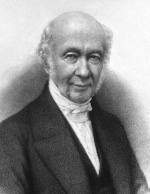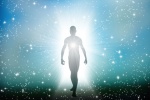Carl Reichenbach
Baron Dr. Carl Ludwig von Reichenbach (February 12, 1788 – January 1869) was a notable chemist, geologist, metallurgist, naturalist, industrialist, and philosopher, who researched about a field of energy combining electricity, magnetism, and heat, emanating from all living things, which he called the Odic force.
He was known for his enormous scientific contribution in European industry and research but also for his humility and deep sensitivity. [1]
Early Years
Carl Reichenbach, the eldest of four children was born on February 12th, 1788, in Stuttgart, the capital of the kingdom of Württemberg. [2] His father was the Court Librarian and archivist in Stuttgart and had Carl educated at the local High School [3] but also supplied him with a rich reserve of arcane treasure, stimulating books about visions of forgotten naturalists. [4] After High School Carl attended the State University of Tübingen studying Natural Sciences. In 1806, he founded a secret society in Tübingen to establish a colony on Tahiti (Otaheiti) in the South Pacific (Otaheiti Society). At the end of 1808 most members were arrested by the Napoleonic police (Germany was occupied by France and ruled from Paris at that time) and detained for some months in the fortress Hohenasperg. Carl resumed his studies after his release and obtained a doctorate [5] in natural sciences and theology and became a knowledgeable and enthusiastic contributor in chemical, geological, metallurgical, and meteorological sciences. [6]
Exemplary Industrial Engineer
After his graduation, Reichenbach, travelled over France and Germany investigating the construction and commercial exploitation of ironworks. He began establishing ironworks in Villengen [7]and Baden, worked for the iron hammer works in Hausach in Baden where he developed and marketed new types of charcoal furnaces. In addition, he established chemical works in Blansko, Moravia, steelworks in Turnitz, Austria, and blast-furnaces in Gaya, Moravia. His wealth increased and he purchased a lot of land in Germany and Austria. In 1835 he acquired the Cobenzl Palace near Vienna. Because of the experiments he carried out in the palace, the Viennese gave him the nickname “Magician of Cobenzl”.
He discovered paraffin in 1830, extracted from coal tar the antiseptic Eupion (1831), the preservative and therapeutic agent Creosote (1832), the indigo dye Pittical (1833) and the red dye Cidreret and other chemicals.
In 1839 Reichenbach was created Baron von Reichenbach by the King of Würtemberg. [8] and his fame and reputation as an industrialist and research scientist spread across Europe. [9]
The Odic Force
But what made Baron Reichenbach go down in history were not his works and discoveries but his theories about a mysterious light phenomenon that some people perceived in the dark, on people (especially on the hands and head) and on magnets and crystals. Reichenbach called the phenomenon 'Od'. For more than twenty years he experimented with hundreds of people who were able to see the light. He set up meticulous tests using magnets, wires, and crystals to find out if someone could feel the odic force. Reichenbach called those who could see the light 'sensitive' and even today psychic research names people who are capable of paranormal perceptions with this word coined by him. Reichenbach found the Odic force, Odic Light, Odic Water, Odic Flames, Odic Glow, Electric Od, and Crystal Od, and he realized that this Odic force is polarized: left-right, up-down, sun-moon, earth's surface-earth's interior. Perhaps that is the deep psychological reason why what was originally a purely scientific investigation became a 'doctrine' - with fanatical supporters and equally fanatical opponents. [10] [11]
Éliphas Lévi Zahed, a very influential French esoteric writer, who is also known for his notion of the all-pervading astral light, admitted readily, that others before him had come across this force but gave it a different name. According to him, the astral light is identical with the Odic Force discovered by Carl Reichenbach – as well as with the animal magnetism, discovered by the German doctor Franz Anton Mesmer and the Azoth achieved by Paracelsus. [12] But the idea of a mysterious vital force or energy permeating nature is an ancient one that has spread under many names over the centuries. It is the Prana of the ancient Hindus, and the Vis Medicatrix Naturae of Hippocrates. It has been rediscovered from time to time as the Mana of Polynesian primitives, the Telesma of Hermes Trismegistus, and the Pneuma of Gallien.[13]
Reichenbach experimented for years and developed his theories about the Odic Force in numerous publications between the years 1845 and 1867. He proposed that the effects of Od can be directly detected by macroscopic movements of objects such as compass needles, and that (electro-)magnets can be detected visually in the dark due to the emission of “odlight”. [14]
Soon after the Baron’s first publication on Od in 1845, the controversy about the nature of the effects of the Odic force began to stir. Although the overall reaction of academia toward von Reichenbach’s claims was rather negative during his lifetime, his writings were very influential on later developments in the context of mesmerism, animal magnetism, and spiritualism during the second half of the 19th century. For example, Mesmerists implied that the discovery of Od validated the concept of animal magnetism. [15]
Last Years and Assessment
Baron Reichenbach had an eventful life, was a creative and spirited man who climbed the highest peaks of scientific reputation and financial prosperity living for some time in the Cobenzl Palace in a magnificent castle, surrounded by flowering meadows. [16] He married in 1810 and the couple had five children, of which two sons and a daughter lived into adulthood. His wife passed away in 1835.
Free from professional occupations and financial restraints, Reichenbach’s involvement with Od began in 1844 and persisted until his death in 1869. Knowing that his days were numbered, von Reichenbach restlessly sought to convince at least one influential personality of his time, Gustav Theodor Fechner, one of the most enigmatic thinkers of nineteenth century German philosophy of the reality of Od.[17]He went to Leipzig in July 1867 against the will of Gustav Theodor Fechner, and stayed there until his death in his hotel room, on January 19, 1869. During this time, he conducted numerous experiments. According to Fechner, Reichenbach grieved up to the last days of his life at the thought of having to die without obtaining recognition for his system. [18]
Seven years later, in 1876, Fechner published an account of his experiences with Reichenbach, which was a silent tribute to Reichenbach. He ended the treatise with the following words:
To be able to repeatedly ascertain a physically magnetic force on the human body, even if only under very special conditions, would in fact be of importance for science, and should one succeed, one would at least be grateful to the od theory for it led the way to it. [19]
If Reichenbach’s experiments concerning unusual visual perception in complete darkness could be replicated with modern equipment and would yield positive results, they would provide important clues for a better understanding of the nature and functioning of our senses, and perhaps also of the aura that some people, like the Theosophist Dora van Gelder can see around human beings and objects. Moreover, should some persons indeed be able to turn compass needles simply by nearing their fingers, assessing the detailed circumstances might also constitute an important step forward toward understanding peculiar motor abilities long attributed to some human beings. Such finding would also indicate that certain aspects of historical concepts on (human) radiations and forces might still be of relevance today and would serve as a reminder that other treasures might also be unearthed in the writings of numerous pioneers who explored border areas of science in the past. [20]
Some years after Reichenbach's death, there was a belated revival of interest in his work by the Society for Psychical Research in Great Britain. It was the possible connection with psychic phenomena that inspired this renewal of interest in a subject pointedly ignored by orthodox science. The committee made careful investigations but was less fortunate than Reichenbach in obtaining suitable sensitives. Only three out of the forty-five individuals tested possessed the sensitivity postulated by Reichenbach, but these three provided interesting confirmation of Reichenbach's observations. In 1908, Walter J. Kilner, who was familiar with the work of Reichenbach, developed a technique for making the human aura visible. In this century, Wilhelm Reich’s theories of "or-gone energy" seem to be about the same energy Reichenbach explored under the label "od."[21]
Notes
- ↑ Vassilator, Gerry. Lost Science, from Baron Karl von Reichenbach, “Luminous World. http://customers.hbci.com/~wenonah/history/odenergy.htm. Accessed on 12/10/21
- ↑ Nahm, Michael. The Sorcerer of Cobenzl and His Legacy: The Life of Baron Karl Ludwig von Reichenbach, His Work and Its Aftermath https://www.researchgate.net/publication/268186991_The_Sorcerer_of_Cobenzl_and_His_Legacy_The_Life_of_Baron_Karl_Ludwig_von_Reichenbach_His_Work_and_Its_Aftermath/link/574374b808ae9ace841b3a7d/download. Accessed on 12/6/21
- ↑ O’Byrne, F.D. Translation and Introduction to Letter on Od and Magnetism by Karl von Reichenbach. Hutchinson & Co., London, 1926. Copyright University Books, 1968, p xv
- ↑ Vassilator, Gerry. Lost Science, from Baron Karl von Reichenbach, “Luminous World. http://customers.hbci.com/~wenonah/history/odenergy.htm. Accessed on 12/10/21
- ↑ O’Byrne, F.D. Translation and Introduction to Letter on Od and Magnetism by Karl von Reichenbach. Hutchinson & Co., London, 1926. Copyright University Books, 1968, p. xvi
- ↑ Vassilator, Gerry. Lost Science, from Baron Karl von Reichenbach, “Luminous World. http://customers.hbci.com/~wenonah/history/odenergy.htm. Accessed on 12/10/21
- ↑ O’Byrne, F.D. Translation and Introduction to Letter on Od and Magnetism by Karl von Reichenbach. Hutchinson & Co., London, 1926. Copyright University Books, 1968. P. xvii
- ↑ O’Byrne, F.D. Translation and Introduction to Letter on Od and Magnetism by Karl von Reichenbach. Hutchinson & Co., London, 1926. Copyright University Books, 1968, p. xxii
- ↑ Vassilator, Gerry. Lost Science, from Baron Karl von Reichenbach, “Luminous World. http://customers.hbci.com/~wenonah/history/odenergy.htm. Accessed on 12/10/21
- ↑ Uccusic, P. Karl Freiherr von Reichenbach (1788-1869) „PsiResumee“, p. 154-156. In German. https://www.paranormal.de/para/ballabene/okkultes_weltbild/aether/reichenbach/reichenbach1.htm Accessed on 12/6/21
- ↑ Vassilator, Gerry. Lost Science, from Baron Karl von Reichenbach, “Luminous World. http://customers.hbci.com/~wenonah/history/odenergy.htm. Accessed on 12/10/21
- ↑ Monika Hauf, Kompendium der Magie und des Okkultismus. Leipzig, Germany: Bohmeier Verlag, 2016, 150-151.
- ↑ O’Byrne, F.D. Translation and Introduction to Letter on Od and Magnetism by Karl von Reichenbach. Hutchinson & Co., London, 1926. Copyright University Books, 1968, page 1
- ↑ Nahm, Michael. The Sorcerer of Cobenzl and His Legacy: The Life of Baron Karl Ludwig von Reichenbach, His Work and Its Aftermath https://www.researchgate.net/publication/268186991_The_Sorcerer_of_Cobenzl_and_His_Legacy_The_Life_of_Baron_Karl_Ludwig_von_Reichenbach_His_Work_and_Its_Aftermath/link/574374b808ae9ace841b3a7d/download. Accessed on 12/6/21
- ↑ Nahm, Michael. The Sorcerer of Cobenzl and His Legacy: The Life of Baron Karl Ludwig von Reichenbach, His Work and Its Aftermath https://www.researchgate.net/publication/268186991_The_Sorcerer_of_Cobenzl_and_His_Legacy_The_Life_of_Baron_Karl_Ludwig_von_Reichenbach_His_Work_and_Its_Aftermath/link/574374b808ae9ace841b3a7d/download. Accessed on 12/6/21
- ↑ Uccusic, P. Karl Freiherr von Reichenbach (1788-1869) „PsiResumee“, p. 154-156. In German. https://www.paranormal.de/para/ballabene/okkultes_weltbild/aether/reichenbach/reichenbach1.htm Accessed on 12/6/21
- ↑ Nahm, Michael. The Sorcerer of Cobenzl and His Legacy: The Life of Baron Karl Ludwig von Reichenbach, His Work and Its Aftermath https://www.researchgate.net/publication/268186991_The_Sorcerer_of_Cobenzl_and_His_Legacy_The_Life_of_Baron_Karl_Ludwig_von_Reichenbach_His_Work_and_Its_Aftermath/link/574374b808ae9ace841b3a7d/download. Accessed on 12/6/21
- ↑ Fechner, Gustav Theodor. Erinnerungen an die letzten Tage der Odlehre und ihres Urhebers [Memories of the last days of the Odic doctrine and its author].https://www.projekt-gutenberg.org/fechner/odlehre/odlehre2.html. Accessed on 12/12/21
- ↑ Fechner, Gustav Theodor. Erinnerungen an die letzten Tage der Odlehre und ihres Urhebers [Memories of the last days of the Odic doctrine and its author].https://www.projekt-gutenberg.org/fechner/odlehre/odlehre2.html. Accessed on 12/12/21
- ↑ Nahm, Michael. The Sorcerer of Cobenzl and His Legacy: The Life of Baron Karl Ludwig von Reichenbach, His Work and Its Aftermath https://www.researchgate.net/publication/268186991_The_Sorcerer_of_Cobenzl_and_His_Legacy_The_Life_of_Baron_Karl_Ludwig_von_Reichenbach_His_Work_and_Its_Aftermath/link/574374b808ae9ace841b3a7d/download. Accessed on 12/6/21
- ↑ Encyclopedia of Occultism and Parapsychology, Reichenbach, Baron Karl von (1788-1869https://www.encyclopedia.com/science/encyclopedias-almanacs-transcripts-and-maps/reichenbach-baron-karl-von-1788-1869. Accessed on 12/12/21



